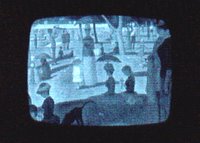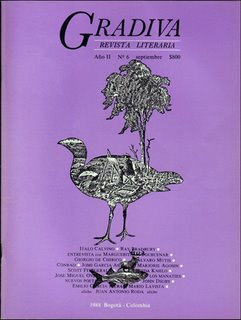"IDENTITY, MARGINALITY, SPACE" - SANART'92 conference / 14 January, 1992. Vakifbank Conference Hall. Ankara, Turkey
Original en español
(Translation: Benoît Junod)
 I am at more than 30.000 feet above the east coast of the United States. The airplane appears to be suspended in the night, immobilized in the air. Nothing can be seen, except the twinkling specters of cities, sprawling like electric stains along the route. There, everything seethes, circulates, hums with frenetic communication. I thumb through a magazine. They screen a film which I don't watch, but whose images gleam intermittently. A selection of baroque, jazz, rock and other music comes through the headphones -all depends on the ‘tuning’. However, I sit with the deceptive appearance of someone not doing anything. I'm thinking about capillarity, electronic circuits, communicating vessels; the way in which television images are produced and pictures in magazines, with their weft and embroidery, like oriental carpets in a pointillist and vibrant Seurat.
I am at more than 30.000 feet above the east coast of the United States. The airplane appears to be suspended in the night, immobilized in the air. Nothing can be seen, except the twinkling specters of cities, sprawling like electric stains along the route. There, everything seethes, circulates, hums with frenetic communication. I thumb through a magazine. They screen a film which I don't watch, but whose images gleam intermittently. A selection of baroque, jazz, rock and other music comes through the headphones -all depends on the ‘tuning’. However, I sit with the deceptive appearance of someone not doing anything. I'm thinking about capillarity, electronic circuits, communicating vessels; the way in which television images are produced and pictures in magazines, with their weft and embroidery, like oriental carpets in a pointillist and vibrant Seurat.I have a feeling that everything is the same; only the organizational pattern varies, the coordinates in which objects are eclipsed and converted into ephemeral events, where they do nothing but palpitate, dance, like the flames of primitive fires, or on television screens, where the important thing is not what is being shown but the fact that it is happening.
 The television is always turned on -or lit, reducing everything to its primeval fire, purifying all differences... On the screen, a naked woman on a beach is a ghostly apparition generated by a certain numerical code. Seurat had perceived it: the world as a transitory illusion, successively disappearing and being reborn. The whole like an electrified stream, moving according to an ultra-sensitive choreography. A pure process of metamorphosis, without hierarchy, equilibrated, non-human, under the spell of its own sufficiency -Monet's "Waterlilies".
The television is always turned on -or lit, reducing everything to its primeval fire, purifying all differences... On the screen, a naked woman on a beach is a ghostly apparition generated by a certain numerical code. Seurat had perceived it: the world as a transitory illusion, successively disappearing and being reborn. The whole like an electrified stream, moving according to an ultra-sensitive choreography. A pure process of metamorphosis, without hierarchy, equilibrated, non-human, under the spell of its own sufficiency -Monet's "Waterlilies".Of course, all this was known; but it hadn't been experienced on such a scale. And it is precisely in that experience, that habits, values, concepts are submerged. One resorts to the faculties of adaptation, of survival which brings understanding.
The future is a place which moves. Before? It was something to come ("l'avenir"), a project. Now, it is a site occupied by its own mobility. To formulate it, somehow, one might say that one has already arrive there. That is also why its spiritual equivalent -illusion- has ceased to behave in the same way. Thus the future is a "now", an immediate installation. A space for all occurrences, where the flux of all memory rushes is residual, fragmentary, within reach of all intervention. Raw material and final product of every process. With a perfect fusion of immediacy and possibility. All times at the same time.
I have always liked Annunciations. The idea of the angel as intermediary, the business of threshold and the symbolic elements which are involved.
There is a painting by Turner which interests me from this point of view, "Rain, Steam, Speed", painted in the first half of the 19th century. In it there is a train -perhaps the first in a painting- which comes from the left background and starts to cross a bridge over a river. The landscape is misty, fuzzy, and the train comes towards us as the Angel does in Annunciations. I think that this iron and steam angel brings a message which has been well confirmed: the advent of the industrial era. But what interests me most is the effect of the train on the structure of the mental landscapes, as it generates an order on relations on the horizontal plane. In other words, the expressive structure is no longer transcendental (above to below) but comes a crude and real image of locomotion.
Nevertheless, another side to the story is told to us by another angel, the one we find sitting, displaced as if by premonition (thoughtful, like Rodin's Thinker) in Durer's "Melancholia", surrounded by an array of motionless instruments and figures. The means are so multiple and so diverse, that we are incapable of defining any objective. Despite this, everything is intrinsically loaded with meaning. It is as if the story -in very broad terms- was lost; therefrom, the title. Nothing, thus, is left-apart from those suggested functions, this enigmatic series of instruments, those imaginary bridges between this and that. Fragments of a puzzle in which distance is constantly marked, and in which the miracle of Fra Angelico's Annunciations can never accomplished.
Finally, with these interpretations, one switches from the vertical relation which determined religious art to the horizon upon which a train goes horizontally from one place to another. The same axis which appears in impressionist paintings, offering still innocently the smoke and steam wrapped landscape as one motif. The amusing thing is that this motif, in Flemish painting, is usually the spire or tower of a church, as single indicator of orientation in the space. Later, with the appearance of this dark and metallic dragon in Impressionism, the character definitions alternate, coming to the very significant principle that where there is a train, there is no spire, and viceversa. Naturally, a "compositional" problem.
On the other hand, neither airplanes nor boats leave tracks. Roads and railways are another matter, a complete network extended over the landscape or under it, with the subway and its subterranean atmosphere, thick with the introspection of the serpent... Yes, we are always moving between invisible frameworks, circulating between zones of low or high energy concentration; interacting in this phenomenon of extended capillarity.
Virgil Thomson, a North American composer, once said that "thanks to electronics and through them, we have left the church to submerge ourselves in life". This is like Turner's train, but on musical territory. There is thus a difference, which both cases demonstrate: an alteration of mental coordinates whose consequence are being taken into account. There is reflection, because historical time has, for once, been checked. And it is not because something has really been stopped, but rather as if somehow control had been lost over the occurrence, the event. The speed of the process is far less voluntarily controlled. The process goes its own way, impelled by its own necessities.
All this reminds me of the well-known experiment, in physics, of communication vessels: Different heights of liquid in such vessels finish by leveling off in common agreement. (The gravity of the matter...). It is thus, essentially, a question of communication effect; of a space each time saturated with mutual influences.
John Cage, another inventor of contemporary music (or sound), can help us substantially to understand all this from another angle. In a radio interview (Paris, 1986) Cage said: "I think transparency, reflections and multiplicity are very important for us, because we live with glass. For example, in that glass outside I see reflected images and colours which are not there but belong to another place. This is our experience."
In Cage's commentary, we can perceive how, with this "aggregate", and through the natural impertinence of daily events, the continuity of the usual discourse is disrupted, with its hierarchies and willfully controlled sovereignty. The path of thought follows, therefore, the unexpected succession of images and events, subject to the phenomenon of transparencies and reflections, to develop in a manner allowing wider participation, closely knit to the performance.
In this I refer to certain procedures used by 20th century aesthetics to attribute particular "permeability" to the "semantics of creation". It is also as if the present level of complexity couldn't be handled within the framework of each individuality. The authority of the Ego, and therefore its "authorship", seem more relative. There is a natural fragmentation of syntax, a recognition of the limits of discourse, which imply that its trustworthiness has to depend on the unthinkable, secret order which has always been the essence of things.
Cage, again, says: "The best way, in my opinion, to escape from number two is to use chance, because this way one can introduce a huge amount of things into a single complex happening. And in this way, one avoids the simplification which is typical of our way of thinking."
Virgin Records... London. My attention is drawn by a record by the group Talking Heads, as it echoes what I have been talking about: STOP MAKING SENSE. A sufficiently explicit statement. Moreover, Selfridges' shop windows are decorated this year with scenes from "Alice in Wonderland". Carroll, Edward Lear (talking heads)... Definitely, nonsense is one of Britain's best traditions.
I went to London for various reasons (one of them is that it was a stop on the way to Turkey). Another, to look for works by a marginal artist. In fact, I had to take a few trains to go to a mental hospital (Bethlem -or Bedlam) outside the city. One gets off at Eden Park Station (a suggestive name). In this place, there is a curious museum of art works by patients. The works are intense, overwhelming.
The previous day, I had been to the British Museum -also with an appointment- looking for more works by Richard Dadd (1817-1886). The author of the hallucinatory pictorial moment "The Fairy Feller's Master Stroke" (the feller in question prepares to smash an enigmatic hazelnut, while a multitude of little persons await attentively the result of the stroke).
Amongst the works I found in the "students room", a minute watercolour retained my attention: "General view of Port Stragglin. The Rock and Castle of Seclusion and the Blinker Lighthouse in the Distance", signed, 1861. The watercolour is 19 x 14 cms., but the space represented is immense. There are maybe over 10 big boats worked in minute detail -with all his sails and implements- on a wavy sea where each individual crest could be counted. All this around a few islands with houses, streets, bridges... On the back, a few comments are written in pencil: "Not a bit like it / not sketched from nature..."
You might wonder why I am talking about all this. Why a nearly unknown artist ? Why this apparently "impertinent" information ? Maybe because the "Castle of Seclusion", in fact, is "...making sense." But more precisely, because in this case I want to match certain aspects of specific marginality with aspects of cultural marginality, which is the sense generally given to the word. I must state that I have no sympathy at all for the imagined analogies between marginality and "third worldliness". I think it is more interesting when within a same cultural environment, marginality appears, like a secession. This is why a Richard Dadd or Lewis Carroll bring a significant difference within the framework of Victorian England. The marginality implies, in this case, an indirect method of criticism, in that individual discourse entails a sense of relativity.
Another example of decentralization is the case of rock groups in Britain in the last three years, who identify themselves with the INDI (independent music) trend. Their idea is to preserve the strength of their creations by recording with equally marginal companies. In this way, concessions are kept to a minimum. Some groups take this idea one step further and dissolve at the very moment of massive recognition. In a way, they prefer independence to success. Paying, perhaps, more attention to the "Blinker Lighthouse in the Distance".
Travels. Their curious narrative. The way they have of going forth to meet things.
Like a film I saw on TV, "Rainman" a film about a trip. Again the idea of "secession", is apparent; also that of "marginality." For those who haven't seen it, it talks about two brothers who didn't know each other (or a culture which ignored its other part). Moreover, one is different from the other -but one is "more" different, Raymond, "Rainman" (Dustin Hoffman), who has always lived among misfits. Tom Cruise, the normal brother, talks a lot and always wants to solve everything with the functional common sense of the average American. Rainman, on the contrary, is nearly like a sorcerer who has lost his tribe. His relation with the world has a different focus and the two brothers meet on the way to a precise place.
It isn't necessary to recount the whole film. In the credits at the end of the film, lies the element I like best. As the names are run through, photographs which Raymond took during the trip are screened. These "marveling" images (and purposely I avoid "marvelous") are out of focus, fuzzy, with erroneous framings where a personal outlook transmutes the rationalized point of view into an unexpected and original revelation, which is nothing else than the "difference" which is contributed.
There is a Hindu thought which I might use to render more accurate the sense I perceive in these pictures. It is by Vijnana Bhairava and says: "At the point when one sees two things, being counscious of the interval between them, where one settles firmly, if one simultaneously excludes both of them, the reality radiates within this interval."
Films are mirrors in motion. Narcissism (that number two) slips away. Objects fall in the intervals.
Ankara and his unexpected snow. I am with friends in a restaurant partly covered with mirrors (there are no women to be seen). For some reason, conversation turns to the question of cultural identities. As you can guess, it is easy to talk, between mirrors, of recognition. We finished by settling on a rather off-central type of reflection, in which one's image does not claustrophobically duplicate the same thing. A mirror for the difference, for what is alien; where a third element might appear which would redeem us from petrifying self-contemplation.
In Turkey, I have felt something relating to great, historical intercultural tensions. I think it is an interesting situation. I also think it is a situation requiring great flexibility. Also, I think that the Turks are wonderful negotiators -apple tea, courtesy, patience.
The world is pure geography. Pure landscape and circumstance. We are never over-attentive or sufficiently attentive to the obvious. If Stevenson's idea in a Dr. Jeckyll and Mr. Hyde film, "If you change the mind you change the man", is one of the most simple and striking understandings of the 19th century, the other perception, which the end of our century brings, is that of the effective capacity of such change. With this appreciation, I refer above all to a fascinatingly complex type of negotiation in which all the traditions which in the last instance identify us, can possibly be intercepted -as in the case of the communicating vessels- on the basis of a common agreement: a practical humanism, implying "transversality" and participation.
Planes, trains, annunciations, electronics, chance, unknown artists, Indi music, films, mirrors... all this is a tiresome circumstantial repertory. The truth is that I don't like markedly theoretical speeches. For this reason, I wanted to interleaf a few ideas which have been interesting me with unexpected material. Its syntax is basically a journey.
I was also in Ephesus, Izmir, Bodrum, Miletos, Xanthos, Antalya, Aspendos, Cappadocia, Konya -even the names are fascinating. In these places there were diverse worlds, from classical antiquity, with its columns and theatres and today's invasive proliferation of tourists; primitive religious manifestation; olive trees and the seduction of Islam. Impossible to recount it all, as it is too fresh, although I already feel the expanding effect within me.
Strange sight those ruins and fragments trying to show retrospective dignity. In the empty theatres, the arguments and plays had evolved somewhat: in Ephesus, they where presenting "Snow"; in Miletos, "Wild Grass"; in Xanthos, "Smell of Wild Thyme"; in Aspendos, "Echoes of Footsteps"... and in Meryemana, the house of the Virgin, the interval was perfect and radiated even in the objects.
Transversality? Permeability, space. Moreover it is not always necessary to build a system on an occurrence.
Let me finish this journey mentioning something which struck me: The Temple of Apollo in Didyma. The columns are titanic (as was the cold). The place is both a temple and an oracle; something like a telecommunications office where the person ordering a call receives an answer beyond normal powers. The sibyl of Didyma was a medium who had to enter a trance, alienating herself by breathing the underground vapors of a well situated in a smaller temple, significantly within the temple of Apollo. Thus after a few formal prerequisites, the sibyl answered in an incoherent, incomprehensible language which then had to be translated -or rather interpreted- by the priests to the person consulting the oracle. Here the problem is not who asks the question, but rather who -or what- gives the answer. Each time the message has to be adapted to another dimension.
What I want to underline here, is the evidence of a forgotten language. The poetical language. The one which is close to the world. That is why Thomson speaks about electronics and churches. That is why the hyperactive language of cybernetics -through the simple gift of capillarity- will recreate contacts, "submerging" us in the world.
In the end, what the oracle says is that meaning is not something that man radiates but rather something that -like Rainman- he perceives. His photographs, his images do not belong to him. They are images shown by the world and which he perceives due to his particular disposition.
In this manner, the Ottoman corner with kilims and cushions where I am writing these lines seems to me perfectly in harmony with a certain contemporary sensibility, a wonderfully woven ornamental dimension, where images of the world are disposed in living geometric patterns. Extensive circuits of vibration, like the turquoise drawings on the ceiling over the central space of the Medrese in Konya, with its pool in the middle around which students gathered to acquire (their feet in the water) the results of ancestral knowledge.
That is why what the art of carpets has recounted to me is no different from what I have been telling you.
------------
QUESTION: Are you trying to know the world or change it?
ANSWER: I think one can act outside these two options.
Q: Do you think that the best voyage in the world is a poetic voyage?
A: Yes. To travel is to try and get in contact with things. What I tried to do in the conference is to merge a theoretical dimension of thought and a level of experience which can not be separated.
Q: Is the hybrid character specific to the Latin American culture or to cultures of countries like Turkey an element that can build a bridge between East and West ? Or is hybridization at the basis of every culture in general?
A: I think that hybrid character is the natural result of a lack of a defined historicism. A word is defined by the way you use it. It isn't a problem of dictionary, it is a problem of functionality.
Q: Could you elaborate the problem of hybrid character?
A: First of all, I am not speaking in the name of any culture personally. Statistically, in my country, there are very few people who think the way I do. In consequence, one can not make generalizations on the basis of my position. However, the text which I have read to you this evening shows that there is a basic reference to all the terms of permeability, hybridization, cross-culture, capillarity, which shows that there is a phenomenon like that which I have been working on.
But if one wants to be still more precise, I would say that where the two or more differences communicate, the result is hybrid. Perhaps one additional thing: I don't see any difference between the term purity and the term hybridization.
...
 Texto leído en el marco de las conferencias pre-simposio y panel de discusiones del encuentro IDENTITY MARGINALITY SPACE, Ankara, Turquía, 1992. Publicado por la Middle East Technical University, Faculty of Architecture. Ver www.sanart.org.tr
Texto leído en el marco de las conferencias pre-simposio y panel de discusiones del encuentro IDENTITY MARGINALITY SPACE, Ankara, Turquía, 1992. Publicado por la Middle East Technical University, Faculty of Architecture. Ver www.sanart.org.tr---

















